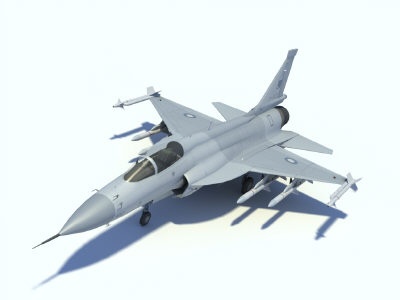really? I've heard you folks say it is a copy of Mig-21, IAR-95, F-16 and now Mig-33. Must be one hell of a hybrid, eh?
So in what way is it a copy?
Mig-33

JF-17

Nose? Nose on the mig-33 is smaller and angled down, whereas the JF-17s is not angled, longer and seems larger in relation to the canopy.
Wings? Both have conventional wing design, whereas the Mig-33's wings are smaller, and swept back.
Air intakes? Completely DIFFERENT!
the engine outlet on the JF-17 is extended and the spine in relation to the sings and canopy are different on either plane.
The JF-17 may have been influenced by it, but the airframe or the aircraft overall is in no way shape or form, copied.
really
Light Fighter FC-1 (Fighter China-1)
The development of this fighter, the improved copy of Soviet MIG-33 (which R&D was terminated due to absence of money at the beginning of 1990s), started at Chengdu Aircraft Industry Corp., in 1994-95.
More exactly, MIG-33 designers resumed this terminated project in Moscow under supervision of experts from Chengdu city and with financing from PLA. In 1995, Chengdu Corp. purchased 100 units advanced RD-93 jet engines, for the future FC-1, at Klimov Aircraft Corp. in St. Petersburg.
In 1997-98, Pakistani Air Forces joined this project; Pakistan provided significant part of R&D financing and is obliged to purchase one half of the future FC-1 production. Despite all the efforts, the project dealt with a lot of problems, and only at the beginning of 2001 did it enter the last stage.
In mid-June 2002, it became known, from Beijing and Taibei sources, that the FC-1 fighter to be used by PLA Air Force in the Taiwan Strait and South China Sea as well as by the Pakistani air force along the border with India will enter serial production in 2003.
It was emphasized that Pakistan, and probably some other developing countries, would pay $25 million for each FC-1, characterized by high combat capacities at low altitude and combat range (with the return to the same airdrome after mission accomplished) of 1,500 km.
Finally, on Sept. 14-19, Xinhua agency, Renmin Ribao and other leading Beijing papers published a series of messages regarding "final success" of FC-1 project (briefly):
Conclusions
In 1982-86, the author worked as a senior engineer at Moscow Machine-Building Salute Plant. The author, with great interest, surveyed a very detailed report from this plant, published in mid-September, in Moscow-based Nezavismoye Voyennoye Obozreniye (Independent Military Survey) weekly paper. Shortly:
Situation at Salute Plant, extremely bad in 1990s, dramatically improved in 2000-2002. This took place due to serial production and export of Liulka-Saturn AL-31FN turbofan engine. Number of Salute employees increased, by mid-2002, up to 12,000, and they are getting an average salary of $400 a month! (Indeed, a handsome salary for Moscow and a fantastic one for any other region of Russia.)
---------- Post added at 12:01 AM ---------- Previous post was at 12:01 AM ----------
Chinese Airshow a Hit With the Military






